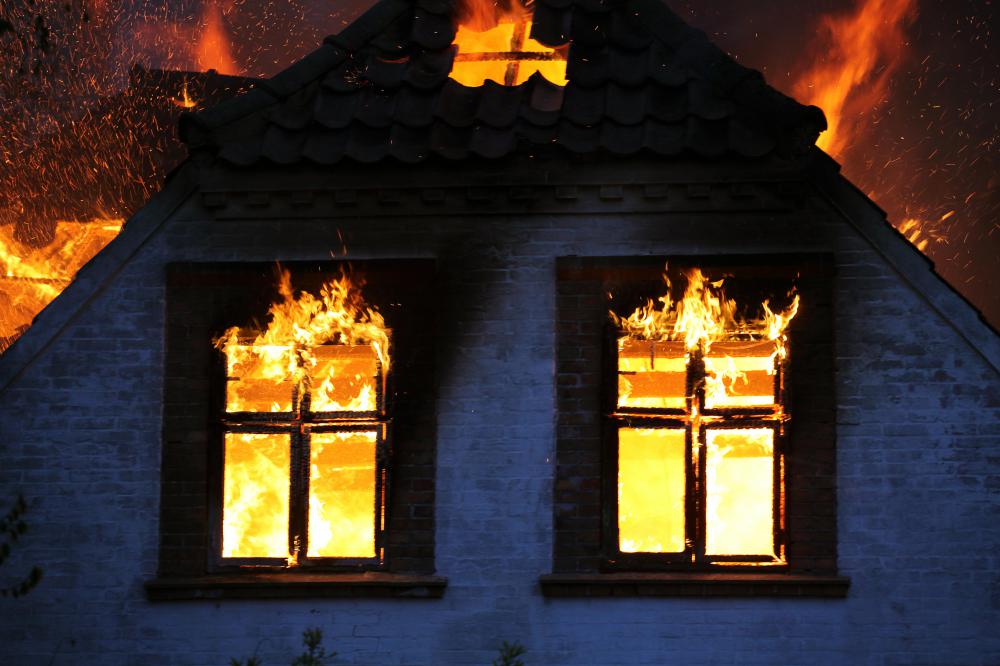At HomeQuestionsAnswered, we're committed to delivering accurate, trustworthy information. Our expert-authored content is rigorously fact-checked and sourced from credible authorities. Discover how we uphold the highest standards in providing you with reliable knowledge.
What is Egress Window Code?
An egress window code is a legal requirement intended to ensure a person can escape a building through a window in an emergency. Most codes also require the windows to be large enough for a fully outfitted firefighter to enter through them. The term "egress" simply means a direct method of leaving a building, and an egress window code requires each bedroom in a home to have a direct exit available in the event of a fire or other emergency.
Building codes often are regulated locally, so there may be differences in the specific requirements for escape routes. In general, though, an egress window code requires a window for each bedroom in a home, as well as one in the basement, if it contains livable space. If there are individual bedrooms in the basement, a separate egress window is required for each.

Most local communities in the United States and Canada have based their building codes on the International Residential Codes (IRC) created by the International Code Council, a membership organization that promotes building safety and fire prevention. These codes were developed with input from both organization members and the construction industry. The IRC includes specifications for egress window sizes and locations, which vary slightly depending on which floor of the house the bedroom is on.

According to the IRC, egress windows should be a minimum of 20 inches (50.8 cm) wide, at least 24 inches (60.96 cm) high, and have a minimum net clearing opening of 5.7 square feet (0.529 square meters) for anything except a ground-level bedroom. The clearing opening is lowered to 5 square feet (0.464 square meters) for a ground-floor bedroom because a ladder isn't needed to escape. The sills on egress windows can be no higher than 44 inches (111.76 cm) from the floor.

For basement egress windows, there are also codes that regulate the sizes of the window wells, which is the area surrounding the window on the home's exterior. The wells must provide 9 square feet (0.83 square meters) of floor space and be a minimum of 36 inches (91.44 cm) in width and height. A well taller than 44 inches (111.76 cm) must include steps or a ladder that is permanently attached. The ladders are required to be at least 12 inches (30.48 cm) wide and not extend more than 3 inches (7.62 cm) above the window well.

Egress window codes were created to provide a safe means of escape from a building, so anything that could hamper that is prohibited. Bars, screens, and grates on an egress window must be easy to open and remove without the use of tools. Any type of window may be used as an egress, but it must provide an opening of at least 22.5 inches (57.15 cm) wide and 36.5 inches (92.71 cm) tall.
Most new homes are built to comply with the IRC recommendations, though homebuyers may want to perform a quick check with the local codes enforcement department for specific details about local regulations. Older homes that were built prior to the adoption of the IRC regulations may not meet the code requirements, although in those cases, an egress window code will typically not be enforced unless the home is renovated. A mortgage lender may require the home be updated to meet code if it is sold or refinanced, however. Even if there are no requirements to add an egress window, it remains a valuable safety feature that will often add value to a home.
AS FEATURED ON:
AS FEATURED ON:














Discussion Comments
Can 1 window be egress capable if there are more than one window per bedroom or do all have to be egress capable?
I just bought an apartment building. I have a unit that is two bedrooms. One of the bedrooms has a window that opens into a hallway that exits the building. Is this legal?
Is the calculation for the size of the entire window (both sashes) or just the one that slides open?
The requirement you are discussing is for an emergency escape and rescue window from bedrooms and basements. This requirement is separate from and should not be confused with the required egress path from a residence. An egress path is through doors, corridors and stairways and cannot pass through a window or a garage. However an emergency escape opening can pass through a door in an exterior wall.
In some states, the opening requirement is only 3.3 s.f. for a double-hung window.
The term "egress window" comes from manufacturers who are not familiar with national building code, but recently Andersen has stopped using it and now simply notes which windows have a 5.7 s.f. clear opening.
I have a walk out basement and in a bedroom a window that the bottom of the window will be at ground level. A 30/40 window will fit in the opening.
The bottom of the widow will be 46" from the floor.
In this instance, do I have to install an egress window?
Any thoughts would be greatly appreciated.
So here's my problem. I'm thinking about re-selling my home and the windows in each of the bedrooms are 46 inches above the floor (rather than the required 44 inches).
However, each of the bedrooms shares a Romeo and Juliet bathroom with a full door exit to the outside (in addition to the entrance to each bedroom from the interior living space). The house was configured as such when we first bought it, but I don't know whether the basement was finished prior to occupancy or whether there was a change.
What was the effective year for egress windows in a finished basement?
The egress code is for firemen wearing their oxygen tanks. That is why it is so large. And the requirement is for sleeping rooms, so a media center or bathroom would be excluded. Bathrooms do require an exhaust vent though, for moist air evacuation.
But whatever it takes to get the permit is the real rule.
Windows must swing outward. That way, if there is a minor explosion, the window will still be able to open versus being stuck in the sash.
You prevent flooding by digging the window well extra deep and back filling with stone so there is a place for it to pond and leach into the soil. If you live in a rainy area, like the east coast, you normally connect the window to the basement drainage which usually leads to a sump.
What are the requirements for a window well in New York city for a basement? I was planning on putting in a 3 foot by 5 foot double hanged window. Also I was going to do a 3 foot by 3 foot window well.
How do you prevent water from flooding the window well when it rains? Also, does a basement bathroom have to have a window?
Why such a large dimension? I weigh 111 pounds soaking wet and could easily exit any window in the house, including awning windows in one bedroom and one bathroom. Is it a matter of people getting larger?
We live in a house full of Labrador retrievers and I admit I'd have some trouble hoisting the 100lb guy out a window. He'd fit but I'm not sure I could pick him up.
How can I find information regarding requirements that screens be provided for windows on the third floor of a residential rental unit in Connecticut?
IRC offers an exception for double hung windows (due to two operable sash). Double hung windows are required to have a net clear opening of 3.3 square feet - which is why the minimum opening must be 24" high by 20" wide. All other means of egress; doors, bulkheads, etc. are required to be a minimum of 5.7 sq ft. Unless these openings are located on the ground floor, in which they are required to be a min of 5.0.
Is there such a thing as a trap door that can be installed as an egress from a basement?
Is there a code requirement for the swing direction of a casement window. That is, can it swing in rather than out?
FYI - a 20" wide window that is 42" in height will most likely not meet egress code. This is because the code requirements are that the clear opening must be 20" wide, 24" high and a total of 5.7 square feet. Most window companies measure windows by the outside of the frame. If you order a 20" wide venting window most likely, the clear opening will be 18" or less.
You will need to speak with the building code division in your area. Many localities require egress windows in all sleeping rooms and a min number in the basement, but this is controlled at the local level.
In a basement, is an egress window required in every room (whether it is a bedroom or not)? I plan on having two egress windows in my basement, but I don't want to put one in a media room (who wants to let light in there?) Is this acceptable under code?
The numbers do not add up. You need to check your math.
Post your comments